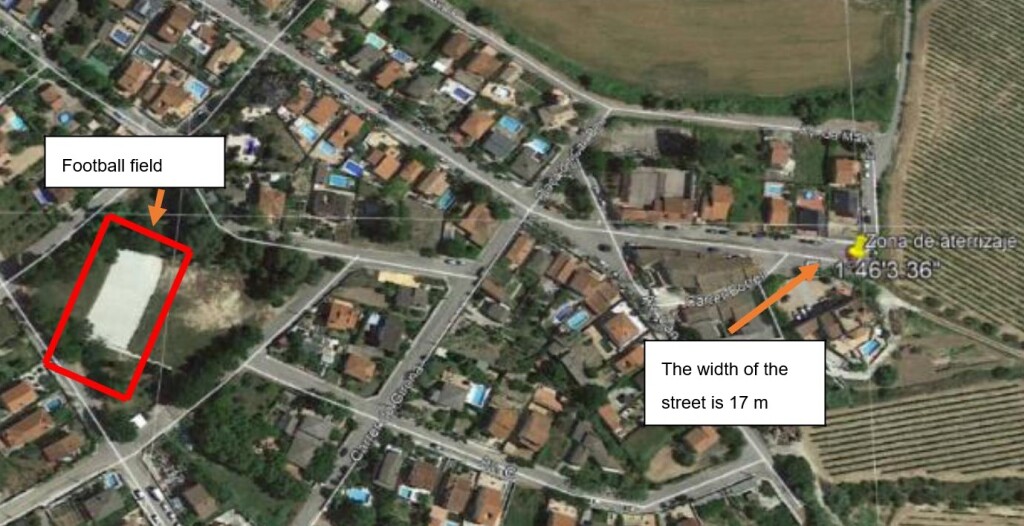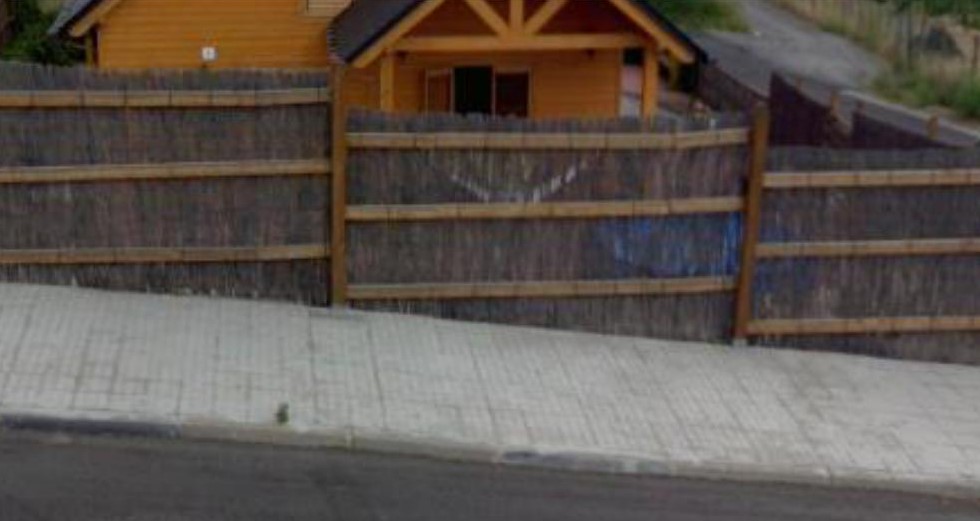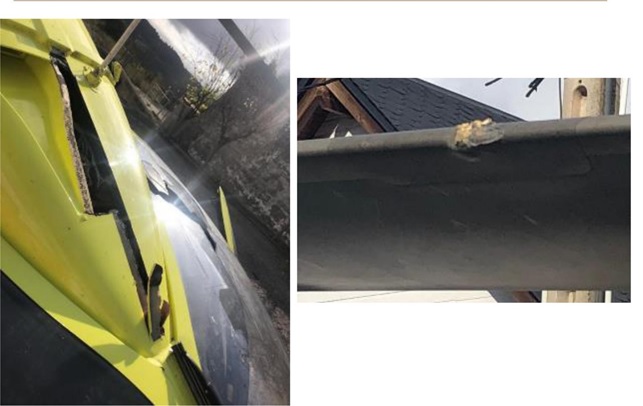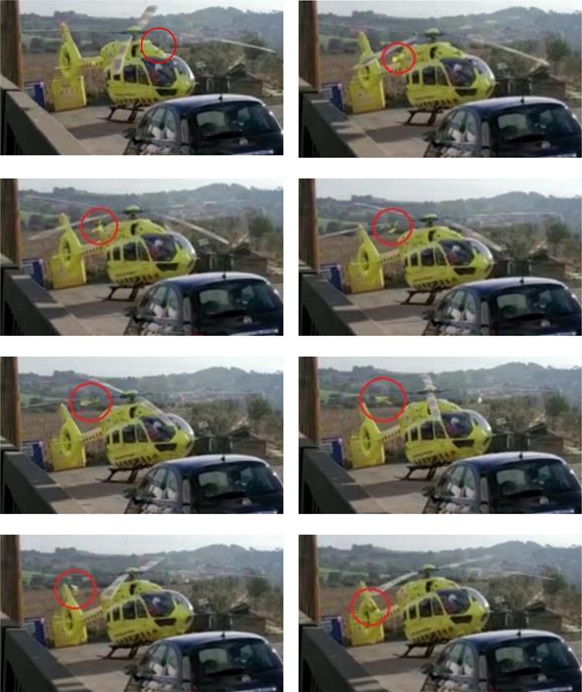Low Recce of HEMS Landing Site Skipped – Rotor Blade Strikes Cable Cutter at Small, Sloped Site (Eliance H145 EC-MJK)
On 16 November 2020 HEMS (helicopter emergency medical service) Airbus Helicopters H145 (BK117D2) EC-MJK, operated by Eliance, suffered a landing accident near Piera, Barcelona. While the helicopter was damaged, the four occupants were unharmed.
The Accident Flight
The Spanish Comisión de Investigación de Accidentes e Incidentes de Aviación Civil (CIAIAC) explain in their safety investigation report (issued in July 2021) that the aircraft had departed Taulí hospital, Sabadell at 10:24 Local Time on a HEMS tasking to attend to a casualty who had fallen 3 m.
On board were the Pilot, a Technical Crew Member and two medical personnel. The pilot had 2190 hours of flying experience in total (70-80 on type but 1300-1400 on the EC135).
The original intent was to land on football pitch 300 m from the casualty, however:
During the flight, the medical team requested the pilot to land as close as possible… [On arrival on scene at] 10:36:37 h, the HEMS TCM identified the house of the person to be assisted. Winds in the area were light, with speeds of between 5 and 8 knots from a 240º direction. Visibility was good.
The pilot replied that…he would have to go around to turn into the wind. He also mentioned that there were rubbish containers and a cable in the vicinity of the patient’s home. Another option for the landing was a nearby field, but the pilot ruled it out as it was fenced off.
The pilot decided to land in the area close to the patient’s home, just behind an ambulance.
This was on a 17 m wide street. As the D value of the H145 is 13.64 m, and the operator required landing sites to be 2D or greater, the chosen site was too small. It was also excessively sloped.
The Flight Manual slope limits are
- Ground sloping nose down (if tail clearance allows) max 10º
- Ground sloping up to the right max 12º
- Ground sloping up to the left max 8º
- Ground sloping nose up max 8º
During the landing, the HEMS technical crew member, the doctor and the nurse helped the pilot to monitor the cables, poles and the position of the rubbish containers.
At 10:39:16 h, the HEMS TCM warned the pilot: “Watch out, MastMoment!” and at the same time, the “MAST MOMENT” warning sounded. The HEMS TCM, “Pull up a moment, pull up a moment”. At 10:39:18 h, the “MAST MOMENT” warning sounded again, and the pilot can be heard saying: “No, now”. At 10:39:19 h, the sound of a rotor blade striking the aircraft cable cutter can be heard. And at 10:39:20 h, the “MAST MOMENT” warning sounded for the third time. At 10:39:57 h, once the helicopter was fully down and the occupants confirmed they were unharmed, they decided to disembark to assess what had happened.
CIAAIC explain that:
The slope in the chosen area exceeded the established limits, causing one of the main rotor blades to hit the upper cable cutter when the pilot lowered the collective to settle the aircraft after touch down.
The damage extended to the cable cutter system, one main rotor blade, the front left cockpit window and one skid strut.
The CIAIAC Safety Investigation
The investigators comment that:.
In a rigid rotor helicopter, high bending forces can be transmitted to the main rotor shaft. In flight, when a pilot performs a cyclical movement, the main rotor disc tilts, the fuselage follows, and the mast bending moment is low. However, when the fuselage is in contact with the ground and cannot follow the main rotor disc, the bending moment can be very high. [The H145] has a mast moment indicator (MMI) to avoid damaging the mast assembly during large cyclical displacements on the ground.
The mast moment indicator limits are as follows:
Orange circumference: 54% to 66%
Red circumference > 66%
White circumference (end of the scale) 100%
The audio warning “MAST MOMENT” is emitted when the red circumference limit is exceeded. The helicopter is also equipped with a one-dimensional indicator:
The pilot has to decide which direction to move the cyclic in order to reduce mast moment.
Analysis of the Flight Data Recorder (FDR) showed that:
At the point of landing, there were three pronounced longitudinal pitches (reflected in rapid variations of the PITCH ANGLE parameter, between -0.14º and + 13.48º). In the first one, the PITCH ANGLE rose sharply from -0.14º to + 10.31º; in other words, the helicopter tilted its nose upwards. The pilot had moved the cyclic control to an advanced-forward position (up to -20%). With the aircraft in contact with the ground, this cyclical position produced a MAST_MOMENT of 98%, activating the MAST_MOMENT_EXC alert one second later.
The helicopter then pitched two more times. The pilot kept the cyclic control in an advanced-forward position. The MAST_MOMENT ranged from 70% to 98%. The aircraft slipped backwards. When the pilot lowered the collective to settle the aircraft, one of the main rotor blades struck the helicopter’s upper cable cutter (coinciding with the extreme values of the longitudinal, lateral and vertical accelerations), and the noise of the impact can be clearly discerned in the recording from the cockpit voice recorder. The impact causes the aircraft to slip backwards again.
The CIAAIC report that:
An individual recorded the helicopter landing with a video camera. [It] shows the aircraft landing at an angle to the longitudinal axis of the street (about 10º to the left of it). This complicated the manoeuvre even further, as the surface was sloping both longitudinally and laterally. In this case, the proximity of the main rotor to the side walls of the street could have produced an added destabilising effect.
The following images, taken from the video, show the rotor blade striking the upper cable cutter. The cable cutter was ejected by the rotor after turning approximately 270º with the blade that struck it. The red circle indicates the position of the cable cutter at different moments.
As can be seen in the recording, the pilot was unable to set the helicopter skid down correctly on the ground due to the sloping terrain during his first attempt.
On the next attempt, the helicopter pitches, and the pilot overrides the movement by lowering the collective. The rotor disc lowers, and the fuselage rises, causing one of the main rotor blades to impact the upper cable cutter.
The CIAIAC determined that:
…the aircraft operator had provided training and established procedures for the proper selection of a landing site.
Extracts are provided in Appendices to their report.
Crucially they note that while the pilot carried out an adequate high reconnaissance orbit, he did not complete the low reconnaissance required in the operator’s procedures.
An internal safety investigation by the operator concluded:
The crew…neglected to identify the sloping terrain at the chosen landing site in sufficient time, focusing their attention on the obstacles in the area instead. The number of obstacles to be monitored generated a saturation of tasks for the crew, leading to a loss of situational awareness due to an excessive external focus.
They elaborate this was…
…believed to be related to the pressure the medical team placed on the crew, given their concern for the patient’s condition.
The operator’s report goes on…
…the pilot did not make the necessary cyclic corrections during the first full skid landing and induced a sequence of two oscillating movements that ended with a loss of control and the rotor impacting the upper cable cutter.
The pilot noted that…
…as part of his recurrent training, training for slope landings only using the flight simulator was received.
However, CIAIAC comment that:
…certain manoeuvres, such as landing on slopes, cannot be adequately trained in a flight simulator, as explained in the document “Teaching and Testing in Flight Simulation Training Devices (FSTD)” prepared by the EHEST group.
Furthermore, the aircraft operator has identified the exclusive use of simulator training for HEMS pilots as a contributing factor in this accident and has decided to reinforce the training of its BK117 D-2/EC145 pilots by including at least one flight instruction session on slope landings and mast moment management.
CIAIAC Conclusion
The accident occurred as a result of landing…in a confined area with a slope that exceeded the established limits.
Safety Resources
The European Safety Promotion Network Rotorcraft (ESPN-R) has a helicopter safety discussion group on LinkedIn.
EHEST (now ESPN-R) Leaflet HE3: Off-Airfield-Landing-Site-Operations
You may also find these Aerossurance articles of interest:
- Air Ambulance B407 Hospital Helipad Deck Edge Tail Strike During Shallow Approach
- Sécurité Civile EC145 Mountain Rescue Main Rotor Blade Strike Leads to Tail Strike
- NTSB on LA A109S Rooftop Hospital Helipad Landing Accident
- Air Ambulance Helicopter Fell From Kathmandu Hospital Helipad (Video)
- US Air Ambulance Near Miss with Zip Wire and High ROD Impact at High Density Altitude
- Hanging on the Telephone… HEMS Wirestrike
- Air Ambulance Helicopter Downed by Fencing FOD
- Ambulance / Air Ambulance Collision
- Beware Last Minute Changes in Plan
- Grand Canyon Air Tour Tragic Tailwind Landing Accident
- A Short Flight to Disaster: A109 Mountain CFIT in Marginal Weather
- US Fatal Night HEMS Accident: Self-Induced Pressure & Inadequate Oversight
- HEMS A109S Night Loss of Control Inflight (N91NM)
- Air Ambulance A109S Spatial Disorientation in Night IMC (N11NM)
- Dim, Negative Transfer Double Flameout
- US HEMS EC135P1 Dual Engine Failure: 7 July 2018
- Misassembled Anti-Torque Pedals Cause EC135 Accident.
- Taiwan NASC UH-60M Night Medevac Helicopter Take Off Accident
- Fatal Fatigue: US Night Air Ambulance Helicopter LOC-I Accident
- Deadly Dusk Air Ambulance Bird Strike
- HEMS Black Hole Accident: “Organisational, Regulatory and Oversight Deficiencies”
- HEMS S-76C Night Approach LOC-I Incident
- Life Flight 6 – US HEMS Post Accident Review
- US HEMS “Delays & Oversight Challenges” – IG Report
- US HEMS Accident Rates 2006-2015
- More US Night HEMS Accidents
- That Others May Live – Inadvertent IMC & The Value of Flight Data Monitoring
- Fatal US Helicopter Air Ambulance Accident: One Engine was Failing but Serviceable Engine Shutdown
- Wire Strike on Unfamiliar Approach Direction to a Familiar Site
- S-76A++ Rotor Brake Fire
- Firefighting AW139 Loss of Control and Tree Impact
- Sécurité Civile EC145 Mountain Rescue Blade Strike
- Sécurité Civile EC145 SAR Wirestrike
- UPDATE 21 August 2021: Air Methods AS350B3 Night CFIT in Snow
- UPDATE 19 September 2021: A HEMS Helicopter Had a Lucky Escape During a NVIS Approach to its Home Base
- UPDATE 7 November 2021: Italian Alps AW139 Mountain Rescue Hoisting Blade Strike
- UPDATE 10 June 2023: EC135 Air Ambulance CFIT when Pilot Distracted Correcting Tech Log Error
- UPDATE 4 February 2024: HEMS Air Ambulance Landing Site Slide
- UPDATE 11 February 2024: Air Ambulance Night Wirestrike at Poorly Chosen Landing Site










Recent Comments